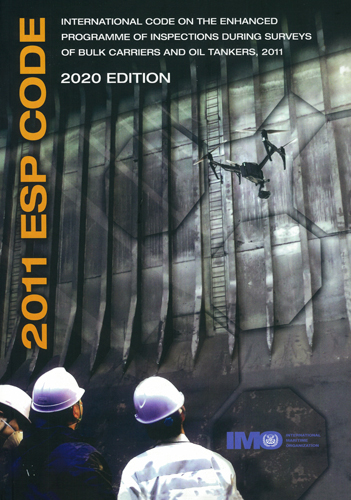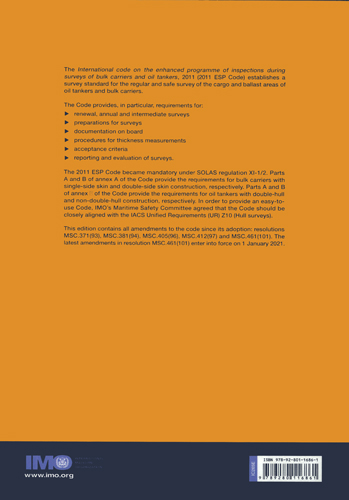Сб с 10 до 16
2011 ESP CODE (International Code on the Enhanced Programme of Inspections During Surveys of Bulk Carriers and Oil Tankers, 2011) 2020 Edition
-
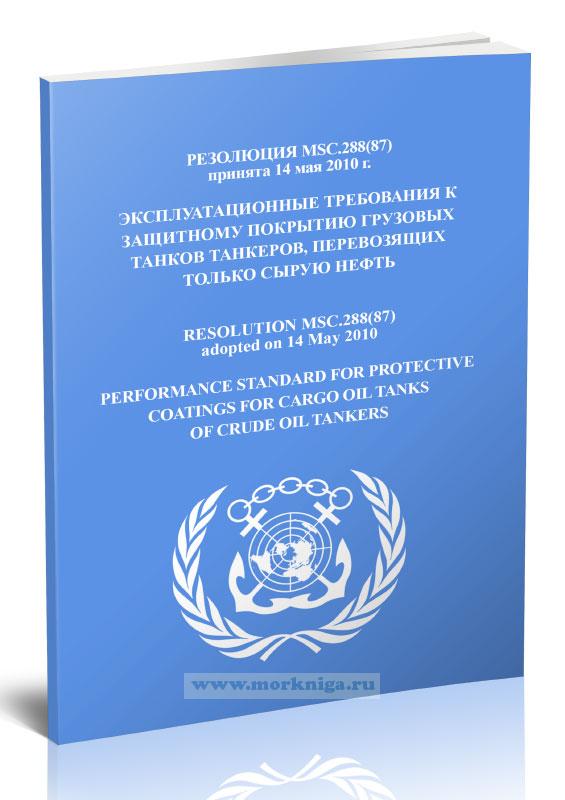 Резолюция MSC.288(87) Эксплуатационные требования к защитному покрытию грузовых танков танкеров, перевозящих только сырую нефть
Резолюция MSC.288(87) Эксплуатационные требования к защитному покрытию грузовых танков танкеров, перевозящих только сырую нефть
-
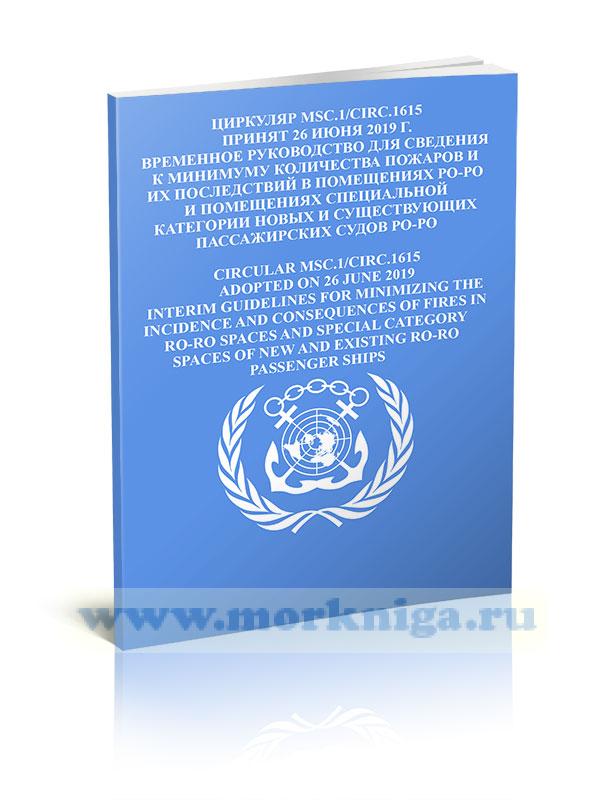 Циркуляр MSC.1/Circ.1615 Временное руководство для сведения к минимуму количества пожаров и их последствий в помещениях ро-ро и помещениях спе
Циркуляр MSC.1/Circ.1615 Временное руководство для сведения к минимуму количества пожаров и их последствий в помещениях ро-ро и помещениях спе
-
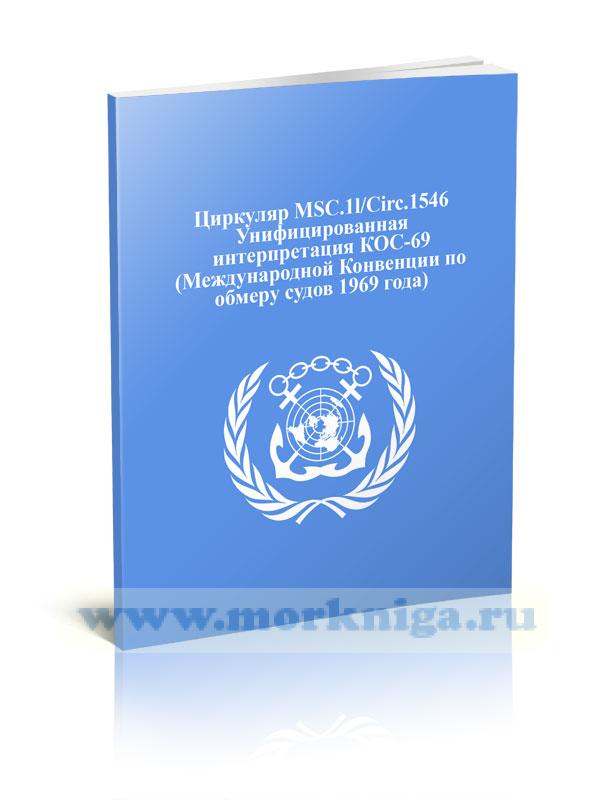 Циркуляр MSC.1/Circ.1546 Унифицированная интерпретация КОС-69 (Международной Конвенции по обмеру судов 1969 года)
Циркуляр MSC.1/Circ.1546 Унифицированная интерпретация КОС-69 (Международной Конвенции по обмеру судов 1969 года)
Отсутствуют стр. с 223 по 242
Издание на английском языке
The International Code on the Enhanced Programme of Inspections during Surveys of Bulk Carriers and Oil Tankers (2011 ESP Code) was adopted on November 30, 2011, and became mandatory through amendments to SOLAS regulation XI-1/2, effective January 1, 2014. This code supersedes the previous guidelines and mandates enhanced inspections for bulk carriers and oil tankers to ensure their structural integrity.
The 2011 ESP Code is also a requirement under the MARPOL Annex I Condition Assessment Scheme (CAS), which verifies the condition of single-hull oil tankers during surveys. The Code is structured into two annexes: Annex A focuses on bulk carriers, detailing inspections for both single-side and double-side skin constructions, while Annex B addresses inspections for oil tankers, including double-hull and other types.
The Maritime Safety Committee (MSC) ensures the Code aligns with the IACS Unified Requirement for hull surveys, promoting simplicity and user-friendliness. Since its adoption, the Code has undergone several amendments to enhance its effectiveness, with the latest changes set to take effect on January 1, 2021.
Contents
Foreword
Resolution A.1049(27)
International Code on the Enhanced Programme of Inspections during Surveys of Bulk Carriers and Oil Tankers, 2011 (2011 ESP Code)
2011 ESP Code
Preamble
Annex A
Code on the enhanced programme of inspections during surveys of bulk carriers
Part A
Code on the enhanced programme of inspections during surveys of bulk carriers having single-side skin construction
1 General
1.1 Application
1.2 Definitions
1.3 Repairs
1.4 Surveyors
1.5 Thickness measurements and close-up surveys
2 Renewal survey
2.1 General
2.2 Dry-dock survey
2.3 Space protection
2.4 Hatch covers and coamings
2.5 Extent of overall and close-up surveys
2.6 Extent of thickness measurements
2.7 Extent of tank pressure testing
2.8 Additional renewal survey requirements after determining compliance with regulations XII/12 and XII/13 of the Convention
3 Annual survey
3.1 General
3.2 Examination of the hull
3.3 Examination of weather decks, hatch covers and coamings
3.4 Examination of cargo holds
3.5 Examination of ballast tanks
3.6 Additional annual survey requirements for the foremost cargo hold of ships subject to regulation XII/9 of the Convention in accordance with the requirements of annex 12
3.7 Additional annual survey requirements after determining compliance with regulations XII/12 and XII/13 of the Convention
4 Intermediate survey
4.1 General
4.2 Single-side skin bulk carriers 5 to 10 years of age
4.3 Single-side skin bulk carriers 10 to 15 years of age
4.4 Single-side skin bulk carriers exceeding 15 years of age
5 Preparations for survey
5.1 Survey programme
5.2 Conditions for survey
5.3 Access to structures
5.4 Equipment for survey
5.5 Rescue and emergency response equipment
5.6 Surveys at sea or at anchorage
5.7 Survey planning meeting
6 Documentation on board
6.1 General
6.2 Survey report file
6.3 Supporting documents
6.4 Review of documentation on board
7 Procedures for thickness measurements
7.1 General
7.2 Certification of thickness measurement firm
7.3 Number and locations of measurements
7.4 Reporting
8 Acceptance criteria
8.1 General
8.2 Acceptance criteria for pitting corrosion for ships built under the IACS Common Structural Rules
8.3 Acceptance criteria for edge corrosion for ships built under the IACS Common Structural Rules
8.4 Acceptance criteria for grooving corrosion for ships built under the IACS Common Structural Rules
9 Reporting and evaluation of survey
9.1 Evaluation of survey report
9.2 Reporting
Annexes
Annex 1 Minimum requirements for ciose-up surveys at renewal surveys of single-side skin bulk carriers
Annex 2 Minimum requirements for thickness measurements at renewal surveys of single-side skin bulk carriers
Annex 3 Owner's inspection report
Annex 4A Survey programme
Annex 4B Survey planning questionnaire
Annex 5 Procedures for approval and certification of a firm engaged in thickness measurement of hull structures
Annex 6 Survey reporting principles
Annex 7 Condition evaluation report (executive hull summary report)
Annex 8A Recommended procedures for thickness measurements of single-side skin bulk carriers not built under the IACS Common Structural Rules
Annex 8B Recommended procedures for thickness measurements of single-side skin bulk carriers built under the IACS Common Structural Rules
Annex 9 Guidelines for technical assessment in conjunction with the planning of enhanced surveys for single-side skin bulk carriers - renewal survey hull
Annex 10 Requirements for extent of thickness measurement at areas of substantial corrosion of single-side skin bulk carriers
Annex 11 Guidelines for the gauging of the vertically corrugated transverse watertight bulkhead between holds Nos. 1 and 2
Annex 12 Additional annual survey requirements for the foremost cargo hold of ships subject to regulation XII/9 of the Convention
Annex 13 Strength of cargo hatch cover securing arrangements for single-side skin bulk carriers
Annex 14 Procedural requirements for thickness measurements
Annex 15 Thickness measurements of side shell frames and brackets in single-side skin bulk carriers required to comply with resolution MSC.168(79)
Part В
Code on the enhanced programme of inspections during surveys of bulk carriers having double-side skin construction
1 General
1.1 Application
1.2 Definitions
1.3 Repairs
1.4 Surveyors
1.5 Thickness measurements and close-up surveys
2 Renewal survey
2.1 General
2.2 Dry-dock survey
2.3 Space protection
2.4 Hatch covers and coamings
2.5 Extent of overall and close-up surveys
2.6 Extent of thickness measurements
2.7 Extent of tank pressure testing
2.8 Additional renewal survey requirements after determining compliance with regulations XII/12 and XII/13 of the Convention
3 Annual survey
3.1 General
3.2 Examination of the hull
3.3 Examination of weather decks, hatch covers and coamings
3.4 Examination of cargo holds
3.5 Examination of ballast tanks
3.6 Additional annual survey requirements after determining compliance with regulations XII/12 and XII/13 of the Convention
4 Intermediate survey
4.1 General
4.2 Double-side skin bulk carriers 5 to 10 years of age
4.3 Double-side skin bulk carriers 10 to 15 years of age
4.4 Double-side skin bulk carriers exceeding 15 years of age
5 Preparations for survey
5.1 Survey programme
5.2 Conditions for survey
5.3 Access to structures
5.4 Equipment for survey
5.5 Rescue and emergency response equipment
5.6 Surveys at sea or at anchorage
5.7 Survey planning meeting
6 Documentation on board
6.1 General
6.2 Survey report file
6.3 Supporting documents
6.4 Review of documentation on board
7 Procedures for thickness measurements
7.1 General
7.2 Certification of thickness measurement firm
7.3 Number and locations of measurements
7.4 Reporting
8 Acceptance criteria
8.1 General
8.2 Acceptance criteria for pitting corrosion for ships built under the IACS Common Structural Rules
8.3 Acceptance criteria for edge corrosion for ships built under the IACS Common Structural Rules
8.4 Acceptance criteria for grooving corrosion for ships built under the IACS Common Structural Rules
9 Reporting and evaluation of survey
9.1 Evaluation of survey report
9.2 Reporting
Annexes
Annex 1 Requirements for close-up surveys at renewal surveys of double-side skin bulk carriers
Annex 2 Minimum requirements for thickness measurements at renewal surveys of double-side skin bulk carriers
Annex 3 Owner's inspection report
Annex 4A Survey programme
Annex 4B Survey planning questionnaire
Annex 5 Procedures for approval and certification of a firm engaged in thickness measurement of hull structures
Annex 6 Survey reporting principles
Annex 7 Condition evaluation report (executive hull summary report)
Annex 8A Recommended procedures for thickness measurements of double-side skin bulk carriers not built under the IACS Common Structural Rules
Annex 8B Recommended procedures for thickness measurements of double-side skin bulk carriers built under the IACS Common Structural Rules
Annex 9 Guidelines for technical assessment in conjunction with planning for enhanced surveys of double-side skin bulk carriers - renewal survey hull
Annex 10 Requirements for extent of thickness measurements at areas of substantial corrosion of double-side skin bulk carriers
Annex 11 Strength of cargo hatch cover securing arrangements for double-side skin bulk carriers
Annex 12 Procedural requirements for thickness measurements
Annex В
Code on the enhanced programme of inspections during surveys of oil tankers
Part A
Code on the enhanced programme of inspections during surveys of double-hull oil tankers
1 General
1.1 Application
1.2 Definitions
1.3 Repairs
1.4 Surveyors
1.5 Thickness measurements and close-up surveys
2 Renewal survey
2.1 General
2.2 Dry-dock survey
2.3 Tank corrosion prevention system
2.4 Extent of overall and close-up surveys
2.5 Extent of thickness measurements
2.6 Extent of tank pressure testing
3 Annual survey
3.1 General
3.2 Examination of the hull
3.3 Examination of weather decks
3.4 Examination of cargo pump-rooms and pipe tunnels if fitted
3.5 Examination of ballast tanks
4 Intermediate survey
4.1 General
4.2 Oil tankers 5 to 10 years of age
4.3 Oil tankers 10 to 15 years of age
4.4 Oil tankers exceeding 15 years of age
5 Preparations for survey
5.1 Survey programme
5.2 Conditions for survey
5.3 Access to structures
5.4 Equipment for survey
5.5 Rescue and emergency response equipment
5.6 Surveys at sea or at anchorage
5.7 Survey planning meeting
6 Documentation on board
6.1 General
6.2 Survey report file
6.3 Supporting documents
6.4 Review of documentation on board
7 Procedures for thickness measurements
7.1 General
7.2 Certification of thickness measurement firm
7.3 Number and locations of measurements
7.4 Reporting
8 Acceptance criteria
8.1 General
8.2 Acceptance criteria for pitting corrosion for ships built under the IACS Common Structural Rules
8.3 Acceptance criteria for edge corrosion for ships built under the IACS Common Structural Rules
8.4 Acceptance criteria for grooving corrosion for ships built under the IACS Common Structural Rules
9 Reporting and evaluation of survey
9.1 Evaluation of survey report
9.2 Reporting
Annexes
Annex 1 Minimum requirements for close-up survey at renewal surveys of double-hull oil tankers
Annex 2 Minimum requirements for thickness measurements at renewal surveys of double-hull oil tankers
Annex 3 Minimum requirements for tank testing at renewal surveys of double-hull oil tankers
Annex 4 Requirements for extent of thickness measurements at areas of substantial corrosion of double-hull oil tankers within the cargo area length
Annex 5 Minimum requirements for overall and close-up survey and thickness measurements at intermediate survey of double-hull oil tankers
Annex 6 Owner's inspection report
Annex 7A Survey programme
Annex 7B Survey planning questionnaire
Annex 8 Procedures for approval and certification of a firm engaged in thickness measurement of hull structures
Annex 9 Survey reporting principles
Annex 10 Condition evaluation report (executive hull summary report)
Annex 11A Recommended procedures for thickness measurements of double-hull oil tankers not build under the IACS Common Structural Rules
Annex 11В Recommended procedures for thickness measurements of double-hull oil tankers built under the IACS Common Structural Rules
Annex 12 Guidelines for technical assessment in conjunction with the planning of enhanced surveys for oil tankers
Annex 13 Criteria for longitudinal strength of hull girder for double-hull oil tankers
Annex 14 Procedural requirements for thickness measurements
Part В
Code on the enhanced programme of inspections during surveys of oil tankers other than double-hull oil tankers
1 General
1.1 Application
1.2 Definitions
1.3 Repairs
1.4 Surveyors
1.5 Thickness measurements and close-up surveys
2 Renewal survey
2.1 General
2.2 Dry-dock survey
2.3 Tank corrosion prevention system
2.4 Extent of overall and close-up surveys
2.5 Extent of thickness measurements
2.6 Extent of tank pressure testing
3 Annual survey
3.1 General
3.2 Examination of the hull
3.3 Examination of weather decks
3.4 Examination of cargo pump-rooms and pipe tunnels, if fitted
3.5 Examination of ballast tanks
4 Intermediate survey
4.1 General
4.2 Oil tankers 5 to 10 years of age
4.3 Oil tankers 10 to 15 years of age
4.4 Oil tankers exceeding 15 years of age
5 Preparations for survey
5.1 Survey programme
5.2 Conditions for survey
5.3 Access to structures
5.4 Equipment for survey
5.5 Rescue and emergency response equipment
5.6 Surveys at sea or at anchorage
5.7 Survey planning meeting
6 Documentation on board
6.1 General
6.2 Survey report file
6.3 Supporting documents
6.4 Review of documentation on board
7 Procedures for thickness measurements
7.1 General
7.2 Certification of thickness measurement firm
7.3 Reporting
8 Reporting and evaluation of survey
8.1 Evaluation of survey report
8.2 Reporting
Annexes
Annex 1 Minimum requirements for close-up surveys at renewal surveys of oil tankers other than double-hull oil tankers
Annex 2 Minimum requirements for thickness measurements at renewal surveys of oil tankers other than double-hull oil tankers
Annex 3 Minimum requirements for tank testing at renewal surveys of oil tankers other than double-hull oil tankers
Annex 4 Requirements for extent of thickness measurements at areas of substantial corrosion of oil tankers other than double-hull oil tankers
Annex 5 Owner's inspection report
Annex 6A Survey programme
Annex 6B Survey planning questionnaire
Annex 7 Procedures for approval and certification of a firm engaged in thickness measurement of hull structures
Annex8 Survey reporting principles
Annex 9 Condition evaluation report (executive hull summary report)
Annex 10 Recommended procedures for thickness measurements of oil tankers other than double-hull oil tankers
Annex 11 Guidelines for technical assessment in conjunction with the planning of enhanced surveys for oil tankers other than double-hull oil tankers
Annex 12 Criteria for longitudinal strength of hull girder for oil tankers other than double-hull oil tankers
Annex 13 Procedural requirements for thickness measurements
